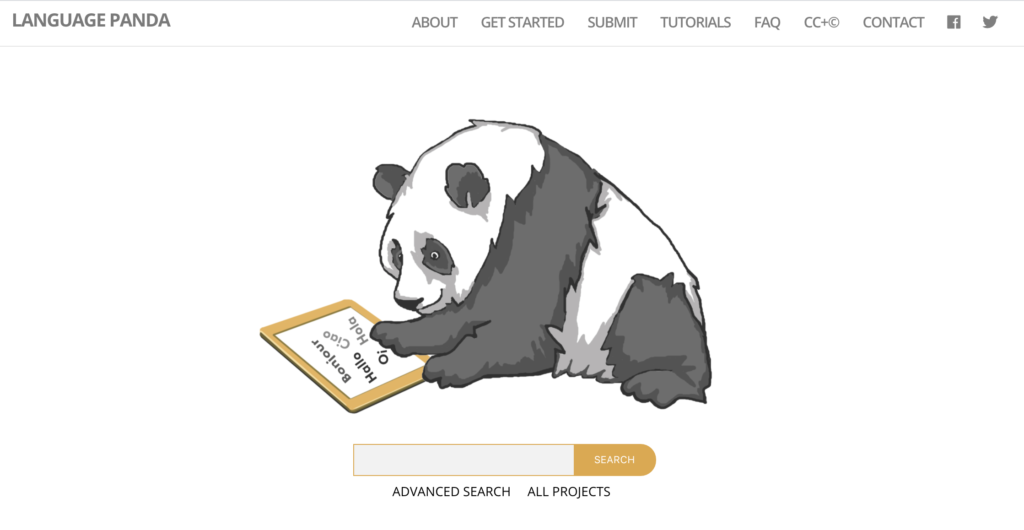Language Panda: A Digital-Tools-Based Lesson Plan Repository
By Melanie Forehand, PhD, Department of Spanish and Portuguese
Center for Second Language Studies Program Assistant
Postdoctoral Mellon Fellow for the Digital Humanities,Vanderbilt University
DOI: https://www.doi.org/10.69732/OWAN3912

When universities and colleges across the country made the abrupt shift to remote teaching this year, professors, instructors, and teaching assistants faced the challenge of transitioning their courses to the online space. Shortly thereafter, list after list of digital tools meant to support this transition flooded our Instagram, Facebook, and Twitter feeds. Although well-meaning, these efforts quickly overwhelmed many of our colleagues who were trying to rapidly adapt their lower-tech teaching methods to the online forum. In this environment of an abundance of lists and a dearth of guidance, members of the teaching community need not only ideas for digital tools, but also standards-based examples of how to incorporate these tools into their courses. To support the effective, mindful incorporation of digital technologies in the online language classroom, the Center for Second Language Studies (CSLS) at Vanderbilt University created the digital lesson plan database, Language Panda, located at www.languagepanda.org.

Language Panda began four years ago as a working group led by graduate students from the language departments of Vanderbilt University. The central issue that the group hoped to address was what we perceived to be an “analog” approach to digital learning. During our time as graduate students, we had seen many examples of innovative digital approaches to teaching language, culture, and literature. At the same time, we realized that most of what we had learned about these digital tools came to us in a very low-tech way; we had either heard about a new tool at a conference or we had seen on-campus colleagues experimenting with websites, software, and apps in their classrooms. To bridge the divide between digital learning and its spread through analog means of communication, the working group decided to create a free, online repository for lesson plans that use digital tools and platforms.
As detailed below, Language Panda addresses three areas of need for instructors. First, it helps to ease the transition to online teaching by providing lesson plans, worksheets, and activities. Second, it fosters a sense of community by allowing instructors to share their ideas and materials with their peers. Lastly, it supports professional development by offering a space for teachers to create and expand their online presence as language instructors.
Searching for Projects
The Language Panda website uses a simple search box interface that allows users to quickly locate digital lesson plans based on a specific need or to browse the entirety of the collection for inspiration.

For those looking for tailored content, our projects are searchable by language, level, creator, topic, keyword, and project length. Search results include the project’s title, language, approximate level, a brief overview, and keywords. Unlike the lists circulating the internet, the materials on Language Panda provide detailed explanations and examples. Upon selecting a project, users see the project’s full entry, which includes a detailed project description, a brief video in which the creators articulate their lessons’ objectives and learning outcomes, relevant information about costs associated with the project, URL links to websites used in the lesson, and lesson plans and worksheets for the activities.
Language Panda currently offers materials for teaching Portuguese, Spanish, French, Japanese, German, and Chinese. And while projects are categorized on the website according to the language the creator teaches, many of our projects are easily adaptable to other languages. We have a variety of short activities for students to practice a concept during a single class period and long-term projects that allow students to develop their understanding of a topic over the course of a semester.
To ensure the quality of materials on our website, graduate students and faculty from CSLS evaluate each submission using the American Council on the Teaching of Foreign Languages (ACTFL) Standards and the ACTFL Role of Technology statement. As the statement reminds us, “The use of technology is not a goal in and of itself; rather technology is one tool that supports language learners as they use the target language in culturally appropriate ways to accomplish authentic tasks” (The Role of Technology in Language Learning | ACTFL, 2017). Our evaluation process ensures that projects prioritize learning objectives and that technology usage serves the purpose of teaching a skill, of transforming existing digital media to check for student comprehension, or of demonstrating mastery.
To help students thrive in the online learning environment, projects on our site utilize digital tools such as websites, apps, and browser extensions that invite students to interact with one another and to apply the information that they are learning. Lessons include presentational tasks based on independent research, self-paced cultural activities, interpretive activities using authentic texts, and interactive lessons using online applications. Here is an overview of just a few of our featured projects:
Social Reading with SocialBook
Author: Abby Broughton
This project uses the platform SocialBook to have students write asynchronous and synchronous reflections on class readings. As the author explains, this reading and writing exercise, “facilitates textual interpretation, cultural connections, and allows students to share what they’re thinking as they think it” (Broughton, 2019). To see her related dissertation research on social reading and learning outcomes, view her webinar.
Writing in Portuguese with Wikipedia
Author: Tim Foster
In this lesson plan, students learn grammatical concepts, practice with scholarly research, and acquire new digital skills. For this semester-long project, students author a section of a Wikipedia page about the city in which they study, provide at least three scholarly citations, and upload a contribution to the site. He asks his students to, “work collaboratively to write a Wikipedia article in Portuguese, requiring them to develop skills that transcend normal language instruction, from real-world cultural research to foreign-language computer coding” (Foster, 2018).
Speaking about Cities with StoryMaps
Author: Melanie Forehand
For this activity, students present research about an assigned Spanish-speaking city using StoryMap JS. Students answer basic questions about landmarks, weather, and tourist attractions in their assigned area and then use Wikicommons to find “high-quality images and provide authorial credit for the images that they incorporate” (Forehand, 2020). By using StoryMap JS, students are able to create an interactive map with their research. This provides students with the opportunity to learn about new places, demonstrate their presentational writing skills, and practice responsible online photo usage.
Sharing Materials with the Teaching Community
Teaching online can be an isolating experience that deprives instructors of the opportunity to meet and exchange ideas with colleagues. Language Panda aims to provide users with a supportive forum for experimentation and innovation, as well as a place in which they are able to share their teaching materials. To that end, we welcome members from across the teaching community to contribute to our database.
On campus, the Center for Second Language Studies runs a weekly workshop that aids instructors in developing projects. Throughout the semester, we introduce digital platforms, invite guest speakers to share their expertise, offer guidance for writing effective lesson plans, and help participants upload their materials to the website. For the broader community of contributors, we have attempted to replicate that support through our Get Started and Tutorial pages.
The Get Started page details the guiding principles of our site and explains the materials that users will need for their submissions. The Language Panda team has worked to make submissions a clear and simple process. For users that are unfamiliar with making screen recordings, we have provided tutorial videos for Mac and PC. Located on the Tutorial page, these videos explain how to record your screen and how to use YouTube to caption your videos.
Once users have prepared their lesson plans and explanatory videos, they may upload their project using the Submit page. All uploaded projects on Language Panda are shared under the Creative Commons “Attribution-NonCommercial-ShareAlike ” license (CC BY-NC-SA 4.0). In addition, when users upload projects, we also ask that they give credit if their project has been inspired by the work of someone else. This ensures that we give credit when credit is due and that we recognize the labor involved in learning new platforms and developing content. After a member of our team has evaluated the project, it will be uploaded and available on our website.
Creating an Online Teaching Presence
Whether you are going on the job market, preparing a tenure file, or reflecting on your pedagogy, you will likely need to create a teaching portfolio. As the Center for Teaching at Vanderbilt University suggests, when compiling a teaching portfolio, evidence of teaching should be, “accompanied by some sort of context and explanation. For instance, if you include a sample lesson plan, make sure to describe the course, the students, and…a reflection on how well it worked” (Teaching Portfolios | Center for Teaching | Vanderbilt University, n.d.).
Each entry on Language Panda is tagged with the contributor’s name, a feature that allows instructors to generate a link to the catalog of their projects on the site. In this way, Language Panda provides users with a platform for articulating their approach to teaching, explaining the context for their lesson plan, and sharing concrete examples with potential employers and with the broader teaching community. With this feature in mind, we recommend that Language Panda contributors include a link to their projects on their personal websites, social media accounts, and especially their teaching portfolios. This ensures that employers and others can observe examples of an instructor’s knowledge, philosophy, and effectiveness beyond student evaluations.
Conclusion
The materials on Language Panda are designed for a variety of users, including K-12 teachers, community college instructors, graduate teaching assistants, lecturers, language program directors, professors, and those working at language schools. Whether you are searching for materials to integrate into your courses or you have ideas that you would like to share with fellow teachers, we invite you to join the Language Panda community.
Be sure to join our online community. Our language center is available on social media on Facebook @Vanderbilt Csls, Twitter @Vandy_CSLS, and Instagram @Vandy_csls. In addition, you can also follow Language Panda @language_panda on Twitter.


Very robust and useful tool, unfortunately I can’t access Language Panda site using the http://www.languagepanda.org/ URL
The author said that the site was temporarily down over the weekend but it should be back up now.
Thank for sharing your experience Melanie, I´ll check out Panga, it seems a useful database teaching plan and project sharing with peers.